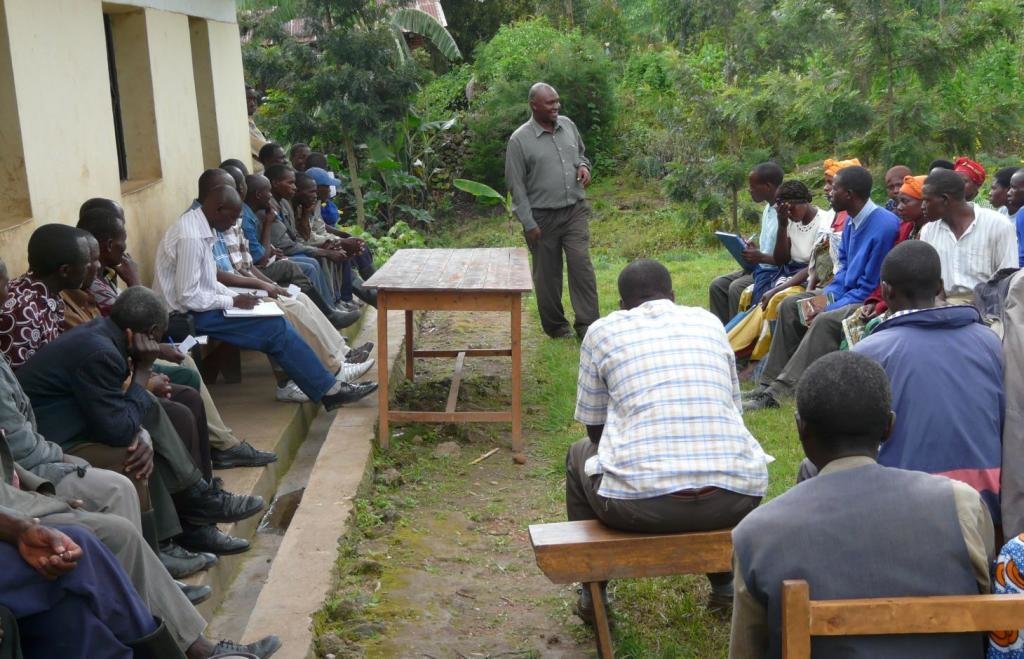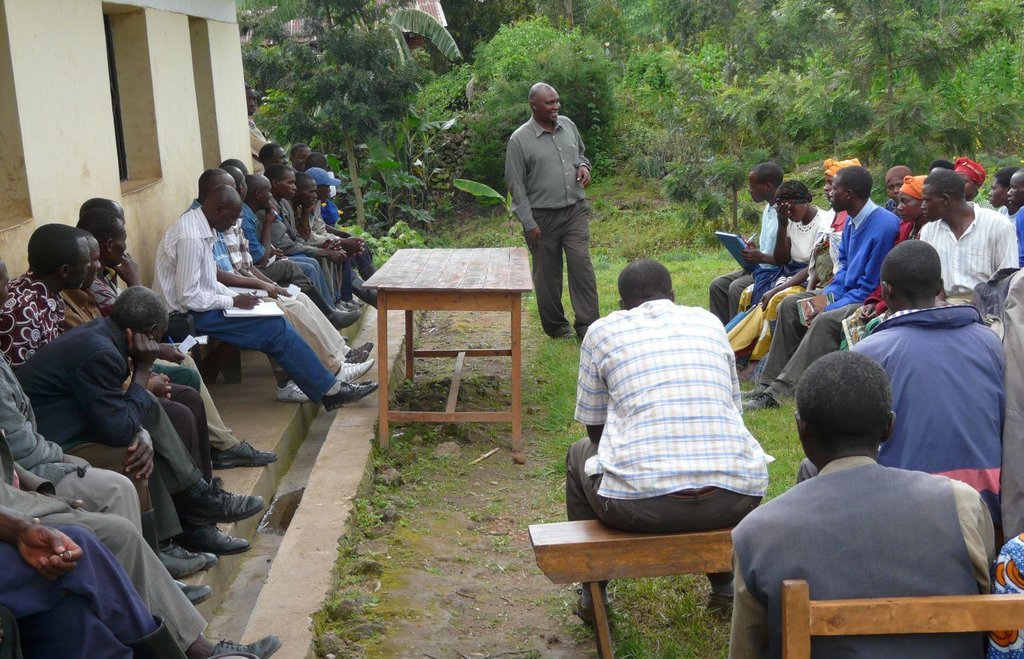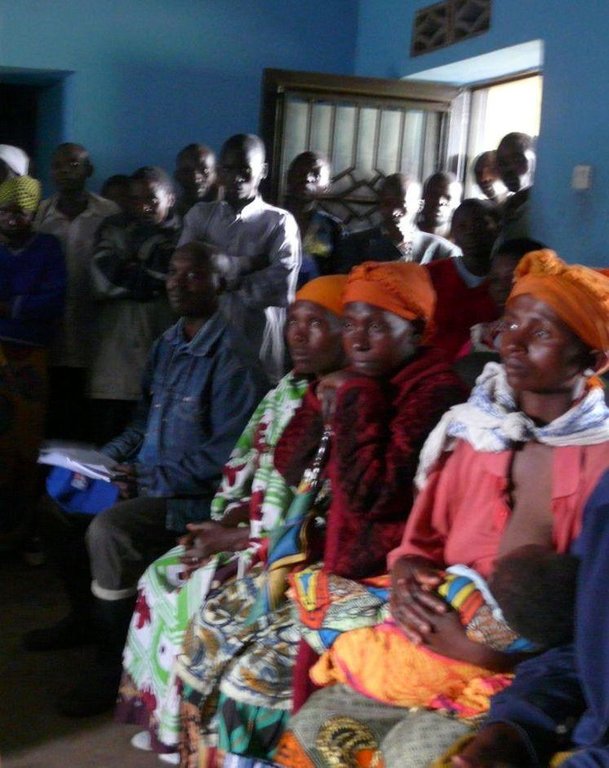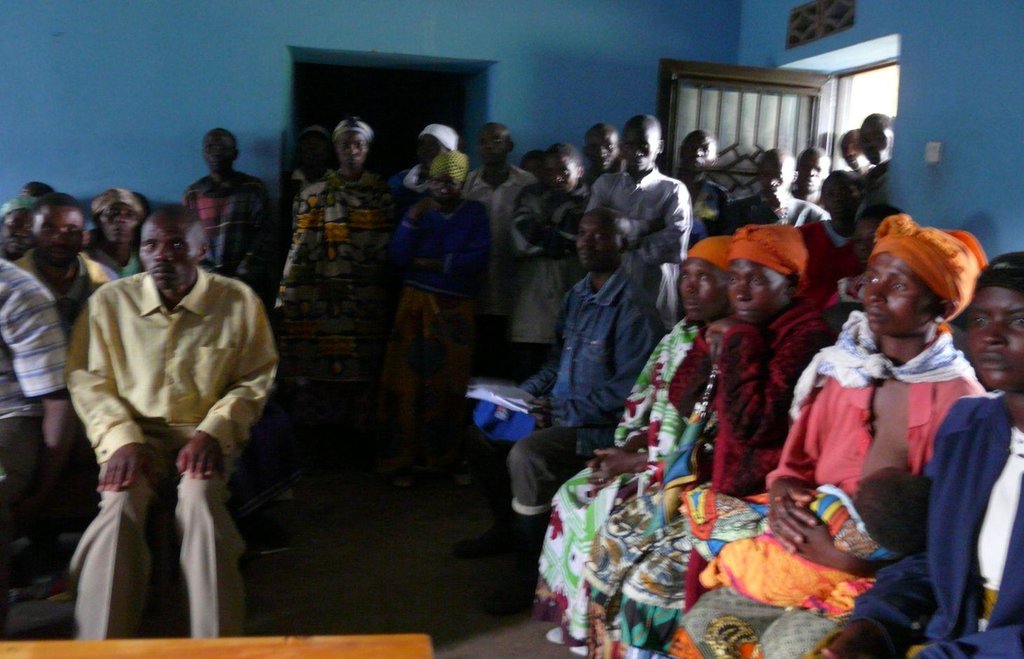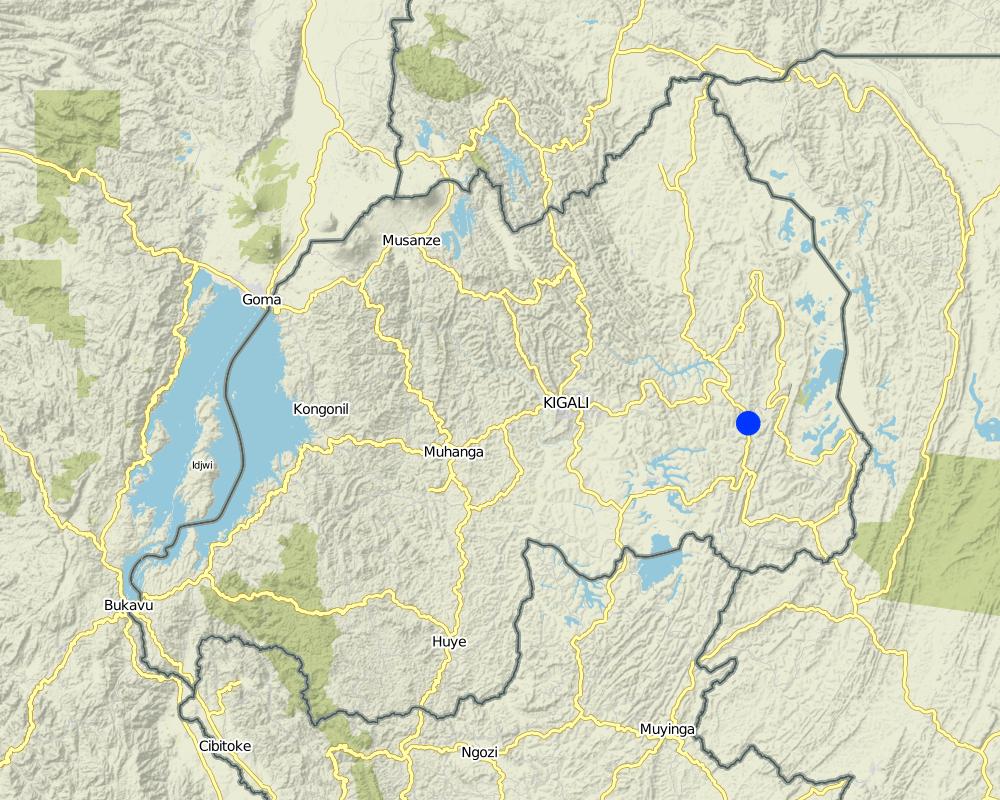Participatory approach [رواندا]
- تاريخ الإنشاء:
- تحديث:
- جامع المعلومات: Desire Kagabo
- المحرر: –
- المُراجع: David Streiff
Ubufatanye bwinzego zose
approaches_2584 - رواندا
عرض الأقسام
توسيع الكل طي الكل1. معلومات عامة
1.2 تفاصيل الاتصال بالأشخاص الرئيسيين لمصدر المعلومات والمؤسسات المعنية بتقييم وتوثيق النهج
متخصص في الإدارة المستدامة للأراضي:
متخصص في الإدارة المستدامة للأراضي:
Muligirwa MULIGIRWAEmmanuel
اسم المشروع الذي سهّل توثيق/تقييم النهج (إذا كان ذلك على صلة)
The Transboundary Agro-ecosystem Management Project for the Kagera River Basin (GEF-FAO / Kagera TAMP )اسم المؤسسة (المؤسسات) التي سهلت توثيق/تقييم النهج (إذا كان ذلك على صلة)
Food and Agriculture Organization of the United Nations (FAO) - إيطاليااسم المؤسسة (المؤسسات) التي سهلت توثيق/تقييم النهج (إذا كان ذلك على صلة)
Rwanda Agriculture Board (Rwanda Agriculture Board) - رواندا1.3 الشروط المتعلقة باستخدام البيانات الموثقة من خلال WOCAT
متى تم تجميع البيانات (ميدانيا)؟:
06/05/2014
يوافق جامع المعلومات والشخص (لاشخاص) الرئيسي لمصدر المعلومات على الشروط المتعلقة باستخدام البيانات الموثقة من خلال WOCAT:
نعم
1.4 المراجع الخاصة باستبيان(استبيانات) تقنيات الإدارة المستدامة للأراضي
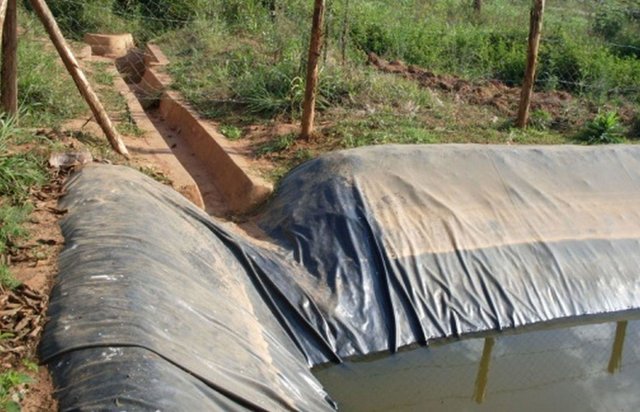
Lining geomembrane plastics for water harvesting and storage [رواندا]
Lining geomembrane plastic for water harvesting and storage is a rainwater harvesting technique used by land users to collect rain water or runoff from a concave watershed to a common well-structured plastic-lined pond for agricultural, domestic and other use.
- جامع المعلومات: Iwona Piechowiak
2. وصف نهج الإدارة المستدامة للأراضي
2.1 وصف موجز للنهج
This approach is a contribution of different stakeholders and land users in the identification and resolution of a particular crop land problems, which implicate at the end different stage of intervention by all stakeholders to resolve the problem.
2.2 وصف تفصيلي للنهج
وصف تفصيلي للنهج:
Aims / objectives: The main goal of the approach is to plan and implement land management activities with villagers in such a way that sustainability is ensured. The specific objectives of the project are to:
(1) increase the capacity of the villagers to design, implement and self-evaluate Soil and water management activities.(2) improve crop production by limiting the effect of dry season during the critical stage of crop growth at the beginning of dry season.
Methods: This approach is integral to the Ministry of Agriculture and Animal Husbandry(MINAGRI) through a long-term project, which was initiated in 2005 and has been financed mainly by the government, with two different part of intervention of farmers which can be a voluntary participation and contributions of the local population or based on food for work.
Stages of implementation: Project extension work is carried out by facilitators from MINAGRI and consists of awareness raising and demonstration.
Problem identification and planning of activities takes place in village meetings. The local land users are supported by MINAGRI personnel who also provide technical and other facilities assistance during the implementation of Soil and Water Conservation measures
2.3 صور عن النهج
2.5 البلد/المنطقة/المواقع التي تم تطبيق النهج فيها
البلد:
رواندا
المنطقة/الولاية/المحافظة:
East
مزيد من التفاصيل حول الموقع:
Kayonza
التعليقات:
The area is not well known it is approximately determined by land users and local authorities.
Map
×2.6 تواريخ بدء وإنهاء تنفيذ النهج
أشر إلى سنة البدء:
2005
2.7 نوع النهج
- local government, diferents stakeholders and land user.
2.8 الغايات/الأهداف الرئيسية للنهج
The Approach focused mainly on SLM with other activities (Reduce sedimentation and irrigation)
Design, test and disseminate alternative technologies adapted to local conditions - strengthen local knowledge of soil and water management measures.
The SLM Approach addressed the following problems: The lack of appropriate ways to develop sustainable technologies to remedy loss of runoff water and poor crop growth in the context of low-input agriculture on gentle undulating land in water scarce areas with an absence of soil conservation measures.
2.9 الظروف التي تمكن أو تعيق تنفيذ التقنية/التقنيات المطبقة بموجب النهج
توفر/الوصول إلى الموارد والخدمات المالية
- معيق
Water harvesting is considered expensive due to material (mainly laying plastic sheet) and labour cost.
Treatment through the SLM Approach: Identification of a low-cost water harvesting measure, which can be implemented during the off-season. Cost-benefit analysis.
المعرفة حول الإدارة المستدامة للأراضي، والوصول إلى الدعم الفني
- معيق
Difficulty in tilling the land when water harvesting structures are in place.
Treatment through the SLM Approach: Integrating new technologies and local knowledge of farmers about the market, into growing more profitable crops (cash crops).
3. المشاركة وأدوار الأطراف المعنية
3.1 أصحاب المصلحة المعنيون بالنهج وأدوارهم
- مستخدمو الأراضي المحليون/المجتمعات المحلية
Decision making
- المنظمات المجتمعية
- متخصصون في الإدارة المستدامة للأراضي / مستشارون زراعيون
- الحكومة المحلية
- الحكومة الوطنية (المخططون، صانعو القرار)
- منظمة دولية
3.2 انخراط مستخدمي الأراضي المحليين/المجتمعات المحلية في المراحل المختلفة للنهج
| انخراط مستخدمي الأراضي المحليين/المجتمعات المحلية | حدد من شارك وصف الأنشطة | |
|---|---|---|
| المبادرة/التحفيز | تفاعلي | |
| التخطيط | تفاعلي | |
| التنفيذ | الدعم الخارجي | |
| الرصد/التقييم | تفاعلي | |
| Research | تفاعلي |
3.4 اتخاذ القرار بشأن اختيار تقنية/تقنيات الإدارة المستدامة للأراضي
حدد من الذي قرر اختيار التقنية/التقنيات التي سيتم تنفيذها:
- متخصصون في الإدارة المستدامة للأراضي بشكل أساسي، بعد التشاور مع مستخدمي الأراضي
اشرح:
Decision were mad by land users and stakeholders.
Decisions on the method of implementing the SLM Technology were made by mainly by SLM specialists with consultation of land users
4. الدعم الفني وبناء القدرات وإدارة المعرفة
4.1 بناء القدرات/التدريب
هل تم تقديم التدريب لمستخدمي الأراضي / الأطراف المعنيين الآخرين؟:
نعم
حدد من تم تدريبه:
- مستخدمو الأراضي
- موظفون ميدانيون/ مستشارون
شكل التدريب:
- مناطق العرض
4.2 خدمة استشارية
هل يملك مستخدمو الأراضي وصولا إلى خدمة استشارية؟:
نعم
حدد ما إذا كانت الخدمة الاستشارية متوفرة:
- في حقول مستخدمي الأراضي
وصف/تعليقات:
Advisory service is quite adequate to ensure the continuation of land conservation activities; Land users are 100% willing to upscale the technology but they are financially not strong enough and unstable.
4.3 تعزيز المؤسسات (التطوير التنظيمي)
هل تم إنشاء أو تعزيز مؤسسات من خلال هذا النهج؟:
- لا
4.4 الرصد والتقييم
هل يشكل الرصد والتقييم جزءا من النهج؟:
نعم
التعليقات:
bio-physical aspects were ad hoc monitored by government through observations
bio-physical aspects were regular monitored by government through measurements
technical aspects were ad hoc monitored by government through observations
technical aspects were regular monitored by government through measurements
socio-cultural aspects were ad hoc monitored by government and land users through observations
no. of land users involved aspects were regular monitored by government and land users through measurements
management of Approach aspects were regular monitored by government through observations
There were no changes in the Approach as a result of monitoring and evaluation
There were few changes in the Technology as a result of monitoring and evaluation: Land users are trying to organise themselves to implement the technology although it is expensive.
4.5 البحوث
هل كانت البحوث جزءًا من النهج؟:
نعم
حدد المواضيع:
- علم الاجتماع
- الاقتصاد / التسويق
- تكنولوجيا
أعط تفاصيل إضافية وأشر إلى من قام بالبحوث:
Research was carried out on-farm
5. التمويل والدعم المادي الخارجي
5.1 الميزانية السنوية لمكون الإدارة المستدامة للأراضي في النهج المذكور
إذا لم تكن الميزانية السنوية الدقيقة معروفة، قم بالإشارة إلى نطاقها:
- 100,000-10,000
التعليقات (على سبيل المثال المصادر الرئيسية للتمويل/الجهات المانحة الرئيسية):
Approach costs were met by the following donors: government: 40.0%; international non-government: 40.0%; local government (district, county, municipality, village etc): 15.0%; local community / land user(s): 5.0%
5.2 الدعم المالي/المادي المقدم لمستخدمي الأراضي
هل حصل مستخدمو الأراضي على دعم مالي/ مادي لتنفيذ التقنية/ التقنيات؟:
نعم
إذا كانت الإجابة بنعم، حدد نوع (أنواع) الدعم والشروط والمزودين:
Care international provided funds (food for work) and the local government provided some equipments (plastic sheets) research staffs and means and training.
5.3 إعانات لمدخلات محددة (بما في ذلك العمالة)
- بناء
| حدد المدخلات التي تم دعمها | إلى أي مدى | حدد الإعانات |
|---|---|---|
| plastic sheets, ciment and fencing wires | ممول بالكامل | |
إذا كان العمل من قبل مستخدمي الأراضي مدخلاً جوهريًا، فهل كان:
- الغذاء مقابل العمل
التعليقات:
Initial stage of implementation were funded by Care and the last stage were done voluntary (maintenance).
5.4 الائتمان
هل تم توفير ائتمان في إطار نهج أنشطة الإدارة المستدامة للأراضي؟:
كلا
6. تحليل الأثر والتصريحات الختامية
6.1 آثار النهج
هل ساعد النهج مستخدمي الأراضي على تنفيذ وصيانة تقنيات الإدارة المستدامة للأراضي؟:
- لا
- نعم، قليلا
- نعم، باعتدال
- نعم، إلى حد كبير
Did other land users / projects adopt the Approach?
- لا
- نعم، قليلا
- نعم، باعتدال
- نعم، إلى حد كبير
Other land users around the technology adapted the technology in their land after being convinced by its importance.
Did the Approach lead to improved livelihoods / human well-being?
- لا
- نعم، قليلا
- نعم، باعتدال
- نعم، إلى حد كبير
Did the Approach help to alleviate poverty?
- لا
- نعم، قليلا
- نعم، باعتدال
- نعم، إلى حد كبير
6.2 المحفز الرئيسي لقيام مستخدمي الأراضي بتنفيذ الإدارة المستدامة للأراضي
- زيادة الإنتاج
To increase crop production
- زيادة الربح (القدرة)، وتحسين نسبة التكلفة إلى العائد
To grow profitable crop like vegetables
- well-being and livelihoods improvement
Reduce povertty by increasing anual incom
6.3 استدامة أنشطة النهج
هل يمكن لمستخدمي الأراضي المحافظة على استدامة ما تم تنفيذه من خلال النهج (بدون دعم خارجي)؟:
- نعم
إذا كانت الإجابة بنعم، صف كيف:
It has create good interaction between land users and other stakeholders.
6.4 نقاط قوة/مزايا النهج
| نقاط القوة/ المزايا/ الفرص من وجهة نظر مستخدمي الأراضي |
|---|
| Building of local knowledge (How to sustain/ enhance this strength: strengthen sensitization by the government) |
| Engagement of researchers with local innovators and thus interaction between scientific and indigenous knowledge (How to sustain/ enhance this strength: This approach can only be sustained if it is mainstreamed into national research and extension services.) |
| نقاط القوة/ المزايا/ الفرص من وجهة نظر جامع المعلومات أو غيره من الاشخاص الرئيسيين لمصدر المعلومات |
|---|
| Capacity building of both land users and researchers (How to sustain/ enhance this strength: strengthen the interaction between SLM specialist and land uses by the government) |
6.5 نقاط الضعف/ العيوب في المنهج وطرق التغلب عليها
| نقاط الضعف/ المساوىء/ المخاطر من وجهة نظر جامع المعلومات أو غيره من الاشخاص الرئيسيين لمصدر المعلومات | كيف يمكن التغلب عليها؟ |
|---|---|
| Appropriate facilitating skills required | Mainstreaming facilitation skills. |
| Time demanding | Less time needed after the first steps of implementation |
7. المراجع والروابط
7.1 طرق جمع/مصادر المعلومات
- زيارات ميدانية، مسوحات ميدانية
- مقابلات مع مستخدمي الأراضي
7.3 روابط للمعلومات ذات الصلة المتوفرة على الإنترنت
العنوان/الوصف:
Kagera TAMP Project website
عنوان الرابط URL:
http://www.fao.org/in-action/kagera/home/en/
الروابط والوحدات المواضيعية
توسيع الكل طي الكلالروابط

Lining geomembrane plastics for water harvesting and storage [رواندا]
Lining geomembrane plastic for water harvesting and storage is a rainwater harvesting technique used by land users to collect rain water or runoff from a concave watershed to a common well-structured plastic-lined pond for agricultural, domestic and other use.
- جامع المعلومات: Iwona Piechowiak
الوحدات المواضيعية
لا يوجد وحدات مواضيعية



